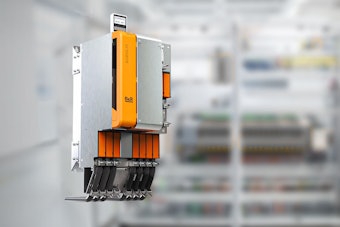
According to a new study from PMMI Business Intelligence, “Robots 2019: Innovation 2 Implementation,” manufactures are turning to robots for five principle reasons:
1. Higher rate of throughput.
2. Removal of human interaction and reduction in labor expenditures.
3. Elimination of repetitive tasks, which improves worker safety while increasing efficiency.
4. Improved product quality and consistency.
5. Flexibility in manufacturing with the emergence of AI and self-learning robots and cobots.
In order to realize the full potential of adding robotics into manufacturing, end users are looking for robots to be modular, flexible, and as easy to program as possible. Robots with these features free up technical resources and human labor that can be used elsewhere on the line.
However, the number-one factor hindering robotics implementation is justifying the investment cost with an acceptable ROI—68% of respondents says this is the largest hurdle to faster growth of adoption of robots. (See Chart)
According to the 56-page report, some CPGs note one hurdle is convincing management to invest in robotics when their belief is, “Things are working just fine.” These same CPGs believe that if OEMs could help demonstrate the improved productivity of robotics, then management might be able to get over the hump and begin to harness the benefits of robotics.
“Robotics need to show a reduction in labor costs and measurable improvements in operating efficiencies and throughput,” remarks a senior packaging engineer from a pharma company who participated in the research.
The study identifies six variables that can be used to compute ROI. These include reduced labor costs, increased throughput, TCO (Total Cost of Ownership), improved quality, including reduced waste, decreased worker injuries and measurable increase in uptime (OEE).
Even with some hurdles, robots are being adopted in food processing and packaging at a blistering pace, particularly in secondary packaging operations (see related article).
Download your FREE 9-page Executive Summary or PMMI Members can download the entire report for free here.
Visit PACK EXPO Las Vegas September 23-25 to see dozens of robots in action, both stand-alone and integrated into packaging machinery as well as the Future Innovators Robotic Showcase.
PMMI’s OpX Leadership Network offers free tools, developed by industry for industry, to calculate OEE and TCO. Access the tools here.
According to a new study from PMMI Business Intelligence, “Robots 2019: Innovation 2 Implementation,” manufactures are turning to robots for five principle reasons:
1. Higher rate of throughput.
2. Removal of human interaction and reduction in labor expenditures.
3. Elimination of repetitive tasks, which improves worker safety while increasing efficiency.
4. Improved product quality and consistency.
5. Flexibility in manufacturing with the emergence of AI and self-learning robots and cobots.
In order to realize the full potential of adding robotics into manufacturing, end users are looking for robots to be modular, flexible, and as easy to program as possible. Robots with these features free up technical resources and human labor that can be used elsewhere on the line.
However, the number-one factor hindering robotics implementation is justifying the investment cost with an acceptable ROI—68% of respondents says this is the largest hurdle to faster growth of adoption of robots. (See Chart)
According to the 56-page report, some CPGs note one hurdle is convincing management to invest in robotics when their belief is, “Things are working just fine.” These same CPGs believe that if OEMs could help demonstrate the improved productivity of robotics, then management might be able to get over the hump and begin to harness the benefits of robotics.
“Robotics need to show a reduction in labor costs and measurable improvements in operating efficiencies and throughput,” remarks a senior packaging engineer from a pharma company who participated in the research.
The study identifies six variables that can be used to compute ROI. These include reduced labor costs, increased throughput, TCO (Total Cost of Ownership), improved quality, including reduced waste, decreased worker injuries and measurable increase in uptime (OEE).
Even with some hurdles, robots are being adopted in food processing and packaging at a blistering pace, particularly in secondary packaging operations (see related article).
Download your FREE 9-page Executive Summary or PMMI Members can download the entire report for free here.
Visit PACK EXPO Las Vegas September 23-25 to see dozens of robots in action, both stand-alone and integrated into packaging machinery as well as the Future Innovators Robotic Showcase.
PMMI’s OpX Leadership Network offers free tools, developed by industry for industry, to calculate OEE and TCO. Access the tools here.
According to a new study from PMMI Business Intelligence, “Robots 2019: Innovation 2 Implementation,” manufactures are turning to robots for five principle reasons:
1. Higher rate of throughput.
2. Removal of human interaction and reduction in labor expenditures.
3. Elimination of repetitive tasks, which improves worker safety while increasing efficiency.
4. Improved product quality and consistency.
5. Flexibility in manufacturing with the emergence of AI and self-learning robots and cobots.
In order to realize the full potential of adding robotics into manufacturing, end users are looking for robots to be modular, flexible, and as easy to program as possible. Robots with these features free up technical resources and human labor that can be used elsewhere on the line.
However, the number-one factor hindering robotics implementation is justifying the investment cost with an acceptable ROI—68% of respondents says this is the largest hurdle to faster growth of adoption of robots. (See Chart)
According to the 56-page report, some CPGs note one hurdle is convincing management to invest in robotics when their belief is, “Things are working just fine.” These same CPGs believe that if OEMs could help demonstrate the improved productivity of robotics, then management might be able to get over the hump and begin to harness the benefits of robotics.
“Robotics need to show a reduction in labor costs and measurable improvements in operating efficiencies and throughput,” remarks a senior packaging engineer from a pharma company who participated in the research.
The study identifies six variables that can be used to compute ROI. These include reduced labor costs, increased throughput, TCO (Total Cost of Ownership), improved quality, including reduced waste, decreased worker injuries and measurable increase in uptime (OEE).
Even with some hurdles, robots are being adopted in food processing and packaging at a blistering pace, particularly in secondary packaging operations (see related article).
Download your FREE 9-page Executive Summary or PMMI Members can download the entire report for free here.
Visit PACK EXPO Las Vegas September 23-25 to see dozens of robots in action, both stand-alone and integrated into packaging machinery as well as the Future Innovators Robotic Showcase.
PMMI’s OpX Leadership Network offers free tools, developed by industry for industry, to calculate OEE and TCO. Access the tools here.
According to a new study from PMMI Business Intelligence, “Robots 2019: Innovation 2 Implementation,” manufactures are turning to robots for five principle reasons:





















